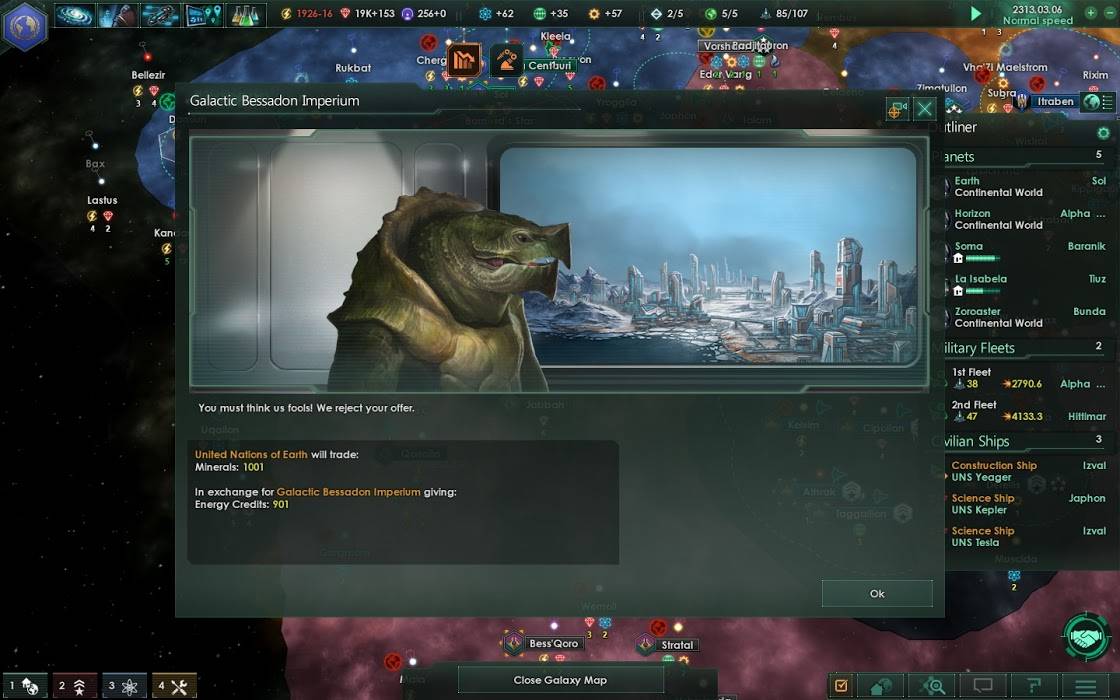Unlike classic 4X games like Civilization, there is no consistent tech tree. While some techs are more powerful, and expensive than others, you’re given a limited number of randomized techs to choose from at a time and, occasionally, an advanced rare tech. This might be frustrating for some players, but I like the way it makes you focus on working with what you’ve got, rather than walking through optimized strategies.
Your basic resources come in the form of Food, Energy Credits, Resources and Influence. Food enables your planets’ populations to survive and thrive; Energy Credits are spent maintaining your various structures; Resources are for building things, and Influence is for political moves like supporting your chosen candidate in an election, or enacting a beneficial edict on one of your planets. Balancing resources seems tricky at first, but I found that I was never really hurting for anything other than influence which grows at a snail’s pace, and is great for expanding your territory and managing your population.

A simple “No” would have been fine.
Communicating with alien species is interesting, if a little shallow. Upon establishing first contact you’re able to see their opinion of you, which is based on both of your traits and ethoses. This works just like the opinion value in Crusader Kings, except it seems that maintaining good relations with your neighbours isn’t that beneficial. In fact, there don’t seem to be too many reasons not to simply crush them into submission. After subjugating one species, they went from hating me to loving me overnight. Then, once they’d rebuilt their fleet, they hated me again. Not that they did anything about it! Their neighbours didn’t seem to care either, unlike Civilization where they’d be denouncing me left right and center. There’s no such thing as a “Most Friends” victory in this game.
As your empire grows, so does the amount of maintenance you have to do. Empire management is a core element of this genre, and managing a galactic empire is most definitely a challenge. Fortunately, you’re able to create sectors, and delegate control of the planets in that sector to a governor of your choice. This frees you up to continue expanding your empire without having to do too much micromanaging.
With that said, the mid to late game definitely requires a change of pace. Early in the game you’re zipping around unclaimed space, meeting the occasional new life form, scanning new systems, and everything seems to happen at a good pace. Once you start growing your territory and meeting your neighbours, you really need to slow down and make sure you pay attention to everything. Managing your surface buildings and spaceport upgrades, keeping track of your neighbours and rivals, deciding where to expand next and how, and keeping your navy upgraded, are all things that require careful thought. You can no longer just leave the speed on maximum and click as you go. This is totally natural for the genre, but it would be nice to have more automation options because of course I want to upgrade my hydroponic farm for 90 minerals. I have 19,000 stockpiled so why wouldn’t I?

War is hell, but looks pretty in Stellaris.
Combat is fairly simple too. You simply direct your fleet to attack an enemy and watch the progress. You’re able to view certain aspects of your enemy’s fleet, which can help you exploit their weaknesses.
The in-game ship designer is one of the coolest parts of the game in my opinion. You’re able to create various ship fits, based on your basic ship types. So you could create a corvette fit with a large torpedo launcher for hit and run battles, or a destroyer fit with point defense lasers to counter missile fleets. There are many different weapon types to choose from, as well as armour, shields, engines, and other attachments.